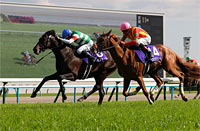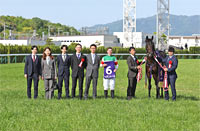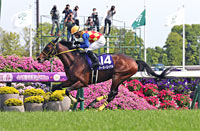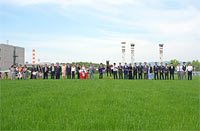Tenno Sho (Spring) (G1) - Data Analysis
Japan’s longest G1 race steeped in tradition
In 2017, the Tenno Sho (Spring) was won by race favorite Kitasan Black (with a record time), with 4th favorite Cheval Grand finishing 2nd, and 2nd favorite Satono Diamond coming in 3rd. In previous years, however, the crown has gone to unfavored runners many times. Horses backed as the 10th favorite or lower have featured in the Top 3 in six of the last 10 years. This year, we will again need to look for runners that may have an advantage in this 3,200m race. Let’s therefore analyze some trends in this top contest that brings to life the Japanese horseracing tradition, based on performances over the last 10 years.
Check performance by favoritism
As noted in the introduction above, unfavorable runners have often dominated the Tenno Sho (Spring) in the past. Looking at performances by favoritism over the last 10 years, we observe that performance has been sluggish for race favorites but favorable for 2nd favorites. Last year’s Tenno Sho (Spring) was won by race favorite Kitasan Black, but that was the first win for the race favorite since Deep Impact won 11 years ago, in 2006. [Table 1]
[Table 1] Performance by favoritism (last 10 years)
| Favoritism |
Performance
[1st-2nd-3rd-4th or lower] |
Win ratio |
Top 2 ratio |
Top 3 ratio |
| 1st favorite |
1-0-1-8 |
10.0% |
10.0% |
20.0% |
| 2nd favorite |
4-1-2-3 |
40.0% |
50.0% |
70.0% |
| 3rd favorite |
1-4-1-4 |
10.0% |
50.0% |
60.0% |
| 4th favorite |
1-3-0-6 |
10.0% |
40.0% |
40.0% |
| 5th, 6th favorite |
0-0-3-17 |
0% |
0% |
15.0% |
| 7th–9th favorite |
1-1-0-28 |
3.3% |
6.7% |
6.7% |
10th favorite
or lower |
2-1-3-78 |
2.4% |
3.6% |
7.1% |
Looking at performances by win odds, we find that the three runners backed by win odds in the 1.0-1.9 range were beaten to 4th or lower. In contrast, runners backed by win odds in the 4.0–9.9 range more often turned in favorable performances. [Table 2]
[Table 2] Performance by win odds (last 10 years)
| Win odds |
Performance
[1st-2nd-3rd-4th or lower] |
Win ratio |
Top 2 ratio |
Top 3 ratio |
| 1.9 or below |
0-0-0-3 |
0% |
0% |
0% |
| 2.0–3.9 |
1-0-2-5 |
12.5% |
12.5% |
37.5% |
| 4.0–6.9 |
5-2-1-6 |
35.7% |
50.0% |
57.1% |
| 7.0–9.9 |
0-3-2-8 |
0% |
23.1% |
38.5% |
| 10.0–19.9 |
2-3-1-16 |
9.1% |
22.7% |
27.3% |
| 20.0–49.9 |
1-1-2-32 |
2.8% |
5.6% |
11.1% |
| 50.0–99.9 |
0-1-0-25 |
0% |
3.8% |
3.8% |
| 100 or higher |
1-0-2-49 |
1.9% |
1.9% |
5.8% |
Watch performance by age
We now turn to performances by age over the last 10 years. While this G1 race is often contested by veteran runners, we note that it is typically younger runners that enjoy success in the race, with nine five-year-olds having finished in the Top 2. It is also worth remembering that four-year-olds have delivered three winners, one runner-up, and five third-place finishes. [Table 3]
[Table 3] Performance by age (last 10 years)
| Age |
Performance
[1st-2nd-3rd-4th or lower] |
Win ratio |
Top 2 ratio |
Top 3 ratio |
| 4-year-olds |
3-1-5-35 |
6.8% |
9.1% |
20.5% |
| 5-year-olds |
4-5-1-39 |
8.2% |
18.4% |
20.4% |
| 6-year-olds |
3-2-2-26 |
9.1% |
15.2% |
21.2% |
| 7-year-olds |
0-1-2-19 |
0% |
4.5% |
13.6% |
8-year-olds
or above |
0-1-0-25 |
0% |
3.8% |
3.8% |
Bracket number also affects performance
In terms of performances by bracket number over the last 10 years, five of the 10 winners started the race in Bracket No. 1, while runners starting the race in Bracket No. 2 achieved a Top 3 ratio of over 25%. In other words, runners starting in the inner brackets have enjoyed success, so this can be regarded as valuable information. [Table 4]
[Table 4] Performance by bracket number (last 10 years)
| Bracket No. |
Performance
[1st-2nd-3rd-4th or lower] |
Win ratio |
Top 2 ratio |
Top 3 ratio |
| 1 |
5-1-1-12 |
26.3% |
31.6% |
36.8% |
| 2 |
1-2-2-14 |
5.3% |
15.8% |
26.3% |
| 3 |
1-1-1-17 |
5.0% |
10.0% |
15.0% |
| 4 |
1-0-1-18 |
5.0% |
5.0% |
10.0% |
| 5 |
0-1-0-19 |
0% |
5.0% |
5.0% |
| 6 |
1-1-2-16 |
5.0% |
10.0% |
20.0% |
| 7 |
0-2-1-24 |
0% |
7.4% |
11.1% |
| 8 |
1-2-2-24 |
3.4% |
10.3% |
17.2% |
Focus on performance in previous race
Of the 30 runners that finished in the Top 3 of the Tenno Sho (Spring) over the last 10 years, 27 contested their previous race in the Osaka Hai (including the period during which the Osaka Hai was still held as a G2 race), the Hanshin Daishoten, Nikkei Sho, or Kyoto Kinen. Runners contesting other races in their last outing delivered lackluster performances. [Table 5]
[Table 5] Performance by previous race (last 10 years)
| Previous race |
Performance
[1st-2nd-3rd-4th or lower] |
Win ratio |
Top 2 ratio |
Top 3 ratio |
| Osaka Hai |
3-3-2-10 |
16.7% |
33.3% |
44.4% |
| Nikkei Sho |
3-3-2-44 |
5.8% |
11.5% |
15.4% |
| Hanshin Daishoten |
3-2-4-48 |
5.3% |
8.8% |
15.8% |
| Kyoto Kinen |
1-1-0-3 |
20.0% |
40.0% |
40.0% |
| Other races |
0-1-2-39 |
0% |
2.4% |
7.1% |
Note: Osaka Hai data reflects the total for 2008–2016, when it was held as a G2 race, and 2017, when it was upgraded to G1 status.
Finish in last race?
Eight of the 10 last winners finished their last race in the Top 2. Although 2014 winner Fenomeno finished 5th in its previous race (Nikkei Sho) and 2012 winner Beat Black 10th (Hanshin Daishoten), runners that turned in favorable performance in their previous races more often have enjoyed success in this race. [Table 6]
[Table 6] Performance in previous race (last 10 years)
| Finish in previous race |
Performance
[1st-2nd-3rd-4th or lower] |
Win ratio |
Top 2 ratio |
Top 3 ratio |
| 1st |
5-5-4-27 |
12.2% |
24.4% |
34.1% |
| 2nd |
3-1-3-22 |
10.3% |
13.8% |
24.1% |
| 3rd |
0-2-1-19 |
0% |
9.1% |
13.6% |
| 4th |
0-0-1-14 |
0% |
0% |
6.7% |
| 5th |
1-0-0-13 |
7.1% |
7.1% |
7.1% |
| 6–9th |
0-2-0-34 |
0% |
5.6% |
5.6% |
| 10th or lower |
1-0-1-15 |
5.9% |
5.9% |
11.8% |
Also look at runners that finished 5th or 6th in a recent graded race
Looking at the Tenno Sho (Spring) over the last 10 years, runners that contested a “graded race as 5th favorite or higher within their last four outings and finished that race 5th or 6th” have featured in the Top 2 in each year other than 2011. In 2017, runner-up Cheval Grand had contested the Arima Kinen (Grand Prix) as 5th favorite two races back and finished that race 6th. If any of this year’s runners come with this kind of record, it may be interesting to check them out. [Table 7]
[Table 7] List of Top 2 finishers in Tenno Sho (Spring) that contested a graded race as 5th favorite or higher within their last four outings and finished that race 5th or 6th (last 10 years)
| Year |
Finish |
Horse |
Race in question |
| 2008 |
2nd |
Meisho Samson |
Previous race |
Sankei Osaka Hai |
2nd favorite |
6th |
| 2009 |
2nd |
Al Nasrain |
Two races back |
American Jockey Club Cup |
3rd favorite |
6th |
| 2010 |
1st |
Jaguar Mail |
Three races back |
Copa Republica Argentina |
1st favorite |
5th |
| 2012 |
1st |
Beat Black |
Two races back |
Diamond Stakes |
4th favorite |
6th |
| 2nd |
Tosen Jordan |
Two races back |
Arima Kinen (Grand Prix) |
3rd favorite |
5th |
| 2013 |
1st |
Fenomeno |
Two races back |
Japan Cup |
4th favorite |
5th |
| 2014 |
1st |
Fenomeno |
Previous race |
Nikkei Sho |
2nd favorite |
5th |
| 2015 |
2nd |
Fame Game |
Four races back |
All Comers |
4th favorite |
6th |
| 2016 |
2nd |
Curren Mirotic |
Previous race |
Hanshin Daishoten |
5th favorite |
6th |
| 2017 |
2nd |
Cheval Grand |
Two races back |
Arima Kinen (Grand Prix) |
5th favorite |
6th |
Note: When there is more than one race in question, the most recent one is shown.
Seek out the winner!
Last four winners finished 2nd–4th in a recent G1 race
The last four Tenno Sho (Spring) races were won by runners that finished “2nd–4th in a G1 race either two or three races back.” The four winners all contested the G1 race in question backed as 4th favorite or higher. [Table 8]
[Table 8] Last four winners finished 2nd–4th in a G1 race either two or three races back
| Year |
Horse |
Race in question |
| 2014 |
Fenomeno |
Two races back |
Takarazuka Kinen |
3rd favorite |
4th |
| 2015 |
Gold Ship |
Three races back |
Arima Kinen (Grand Prix) |
1st favorite |
3rd |
| 2016 |
Kitasan Black |
Two races back |
Arima Kinen (Grand Prix) |
4th favorite |
3rd |
| 2017 |
Kitasan Black |
Two races back |
Arima Kinen (Grand Prix) |
2nd favorite |
2nd |
(Yasunori Asano)
|



















